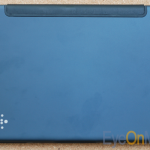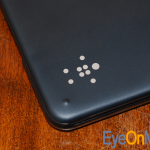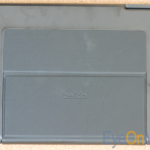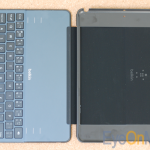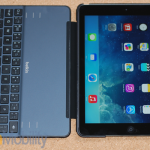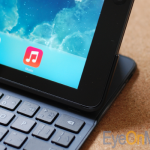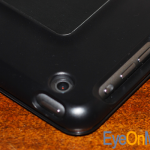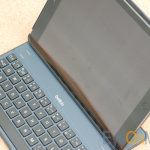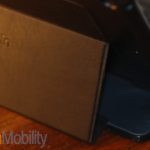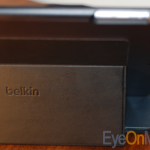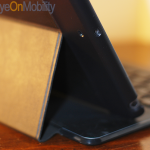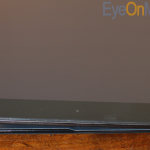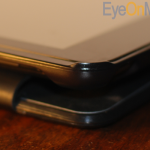Introduction:
While mobile operating systems such as iOS are quickly catching up to the functionality offered by desktop operating systems, software keyboards often remain a poor substitute for hardware keyboards, thereby limiting tablets’ functionality for certain purposes. For example, while I am open to using the iPad’s software keyboard to do short posts for EyeOnMobility, reviews are another matter. Fortunately, keyboard accessories are available to bring tablets one step closer to the full functionality of a laptop.
With the recent launch of the iPad Air, accessory manufacturers have been updating their portfolios to support Apple’s latest tablet. Belkin was among the first to announce new keyboard accessories for the iPad Air. It announced three keyboard cases with the Belkin Qode Ultimate Keyboard being its top-of-the-line offering.
Thanks to Belkin, we have taken the Qode Ultimate Keyboard for iPad Air for a spin and written nearly the entire review with it. Read on to find out what we think of it.
A closer look at the Belkin QODE Ultimate Keyboard case
As the name implies, the Belkin QODE Ultimate Keyboard Case combines an iPad case with a physical keyboard. It consists of three main components each of which has dual roles: The keyboard doubles as the front cover, the back cover doubles as the case and the hinge also serves as a kickstand.
The keyboard portion or bottom of the case if you prefer is made of aluminium. The bottom is plain with two small dimples at the front to presumably raise the keyboard ever so slightly from flat surfaces.The keyboard itself is made of five-rows of plastic chicklet keys. It includes four arrow keys as well as function keys to control specific iOS functions. On the right side, you will find a microUSB charger port and a status light next to it.
The top portion of the case is really a case for the iPad Air. Unlike the bottom, it is made of polycarbonate plastic. Cutouts ensure that ports, the camera and controls remain accessible while the iPad Air is in the case. As you can see from the images, the plastic is a bit of fingerprint magnet.
The faux-leather hinge also acts as a kickstand to keep the iPad angled so that you can see it while typing away. There are no buttons on the keyboard case itself. For example, you will not find a power button – We’ll explain why a bit later on.
- Bottom of the keyboard case
- Closeup of the bottom of the case
- Top of the keyboard case
- Empty open case
- Open case with iPad Air
- Front closeup
- Closeup of the case cutouts
The keyboard feels extremely stable when on a flat surface such as a table or desk. With the iPad sitting above, one might think it could be top heavy but Belkin has found a way to balance the case out so that this is not an issue. Even when using it on my lap in those cases where a flat surface is not available, I found it surprisingly stable and useful.
At just over 400 grams, the keyboard is light but that does not mean that it feels cheap or fragile. It is solidly built and has withstood my travels during the review period very well. Despite having traveled (often without being in a bag) across town and being tossed on the car seat (and even flying off it onto the floor once), it shows few signs of wear and tear.
Using the Belkin QODE Ultimate Keyboard case
The first thing you will need to do is seat the iPad Air into the Ultimate Keyboard. This is as straightforward as can be: Much as you would slip your smartphone into a bumper case, you simply have to insert the iPad into the case and press the four corners in to secure it in place. The fit is snug and the tablet will remain solidly in place. While held securely, it also remains easy to remove it should the case not be needed at some future point. To to so, you simply push it out from the case.
The case is also easy to open. There are no clasps or buttons to press; you simply pull on a lip on the front and pull it open. The enclosure magnets are strong enough to keep the case closed under normal circumstances without making it overtly difficult to open the case when needed. Once open, the case’s hinge becomes a kickstand, allowing you to position the iPad at three different viewing angles. Each of these is conveniently marked on the flat area behind the keyboard. Dual neodymium magnets secure (and even guide) the iPad into the desired position. When the iPad locks into position, the keyboard turns on automatically. You do need to put it down on the stand to turn it on though; simply opening the case will not do the trick.
The viewing positions provide subtly different viewing angles. In other words, there is not a huge difference between the three and it’s likely that you will find one that quickly becomes your favourite. At the same time, choices are always a good thing as many keyboards do not provide this option.
- Ready for action
- Hinge closeup
- Front closeup
- Hinge back
- Another side view of the hinge
The case is also designed in such a way that the keyboard can be tucked away when not needed. It folds down and away behind the iPad. The keys face inwards so that they are protected and your hands rest against the smooth aluminium bottom. While it’s not quite as comfortable as holding the iPad by itself, it is a convenient feature that prevents you from having to pull the iPad out when it’s not needed. I do wish Belkin had added a magnet to hold it in place as the bottom does shift a bit when in this position.
- Keyboard folder under the iPad
- A closer look
As for the keyboard itself, we need to keep in mind that it’s one designed for a 9.7-inch tablet. It is more compact than traditional full-size keyboards. As such, you will find it somewhat cramped when compared to larger-sized keyboards. Despite the size limitations imposed by the iPad itself, typing is quite comfortable. The keys are of an adequate size and provide good travel and good tactile feedback. Spacing between keys is adequate.
The keyboard layout may take some getting used to as there are a few keys that are not where you might necessarily expect them to be. Belkin has also added a row of iOS function keys but these are combined with the number keys, requiring that you press the Function key at the same time to execute the desired command. This is not a huge drawback and better than the alternative of an additional row of keys, especially if it would make the overall keyboard smaller. Among these are keys for a Home key, cut and paste functions and volume controls. Anyone used to Mac key combinations using the Alt and Command keys will feel at home on this keyboard as well.
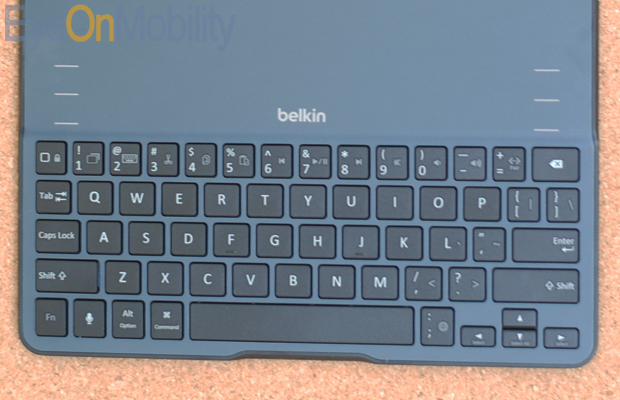
The actual connection between the keyboard and iPad is made via Bluetooth. Initial setup is straightforward and I never experienced any connectivity issues. There were some times when the Bluetooth connection took a brief moment to establish itself but it was never more than one or two. Just enough to notice that it was happening and nothing unusual when working with Bluetooth.
While there is a status light on the right side of the keyboard next to the micro-USB port, it is difficult to see unless you look to the side. As such, I found it of little value and almost never thought of looking at it.
For those occasions when you want to use the iPad on the kickstand without needing the keyboard, there is no way to turn off the keyboard to save battery life. With Belkin promising impressive battery life, this has not proven to be an issue though.
Speaking of battery life, it is quite impressive. Belkin promises 264 hours (11 days) of active battery life and 4,300 hours (nearly 180 days) of standby. In the three weeks that I played with it for the review, I only charged it once and only because I knew that I was going out and would need it for several hours and was not sure how much battery life I had left. And this brings up one of the few flaws with this accessory: There is no way to tell how much battery life remains.
As for charging, the keyboard is charged using the micro-USB connection (Belkin even provides the necessary cable) on the right side. The status light will light up while it’s charging.
As we mentioned earlier, the Belkin QODE Ultimate Keyboard does not come with a power button. Instead, the keyboard itself is able to turn itself off when there is no activity for a certain amount of time. Combine that with the long battery life and I can say that I liked the convenience of never having to think about turning off the keyboard when I did not need it.
While the case will protect your iPad Air from the day to day scrapes and dings, don’t expect it to protect it from a big drop. If anything, I have the feeling that you would end up with a damaged tablet and keyboard case. It certainly will protect the screen from certain kinds of impacts. It is also not designed to protect the iPad Air from liquid damage.
In the end, there is little that I wish that Belkin had done differently with the QODE Ultimate Keyboard. But there is one feature I would have liked to have: Backlit keys with the option to turn it hem off to save battery life when not needed.
Pros
- Solidly built but light at the same time
- Excellent keyboard typing experience
- Keyboard folds away neatly when not needed
Cons
- No battery status indicator
- No keyboard key backlight
Conclusions:
At CA$129, the Belkin Qode Ultimate Keyboard for iPad Air is a worthy accessory for those situations where a physical keyboard is required. While there are precious few alternatives currently available, this is a situation that will likely change over time but Belkin has set the bar high for its competitors. It may not be the cheapest out there but the Belkin QODE Ultimate Keyboard is a light but solidly built case that gives you a comfortable physical keyboard for those times that the software keyboard will not do. It will also protect your iPad Air from the tribulations of daily commute and travel.
The Belkin QODE Ultimate Keyboard Case is available in black (like our review unit) as well as white and silver. It is compatible not only with the iPad Air but also with the iPad 2 and the third and fourth generation iPads.
Priced at CA$129, it is available directly from Belkin’s website.

